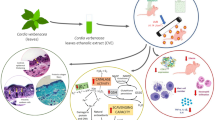Summary
The four lignans: podophyllotoxin, 4′-demethyl-podophyllotoxin, α-peltatin and β-peltatin represent the podophyllin ingredients believed to exert lesional necrosis after application to condylomata acuminata. This study comparatively evaluates cutaneous cytodestructive potency of these drugs, as evaluated by measurement of epidermal and dermal 3H-thymidine incorporation and injury of dermal microcirculation at intervals in the range of 9–168 h after application to hairless mouse skin. Influence on DNA-synthesis was measured using a disc technique for isolation of standardized skin areas followed by alkali extraction of DNA from respective tissues after separation through Potassium bromide incubation. Any capillary injury was demonstrated by visual assessment of leakage of i.v. injected trypan blue to test areas. An analytical method compensating for variations in DNA synthesis in individual controls is presented. Using 0.5% preparations of the lignans, podophyllotoxin most consistently influenced the variables indicating cytodestructive effect, while 4′-demethyl-podophyllotoxin exerted the weakest degree of damage.
Similar content being viewed by others
References
Cochran W, Cox G (1957) In: Experimental designs, chap 3. Wiley & Sons, New York London, pp 62–75
Culp OS, Kaplan IW (1944) Condylomata acuminata. Two hundred cases treated with podophyllin. Ann Surg 120:251–256
Dixon WJ, Massey FJ (1957) In: Introduction to statistical analysis, 2nd ed. McGraw-Hill Book, London New York, p 152
Emmenegger H von, Stähelin H, Rutschmann J, Renz J von, Wartburg A von (1961) Zur Chemie und Pharmakologie der Podophyllum-Glucoside und ihrer Derivate. Arzneimittelforsch 11:327–333
Fisher LB (1975) Psoriasis and cell kinetics. The use of mouse and human skin models. In: Maibach HI (ed) Animal models in dermatology. Churchill & Livingstone, Edinburgh London New York, pp 234–247
Fisher LB, Maibach HI (1975) The effect of anthralin and its derivatives on epidermal cell kinetics. J Invest Dermatol 64:338–341
Fraas Clausen OP, Thorud E (1980) Perturbation of cell cycle progression in mouse epidermis prior to the regenerative response. J Invest Dermatol 75:129–132
Garvey JS, Cremer NE, Sussdorf DH (1977) Methods in immunology, 3rd ed. Benjamin, London Amsterdam Sydney Tokyo, pp 456–458
Halprin KM, Taylor JR, Levine V, Adachi K (1979) A combined alkali extraction — ethidium bromide technique for the measurement of DNA in small pieces of tissue. J Invest Dermatol 73:359–363
Hegazy MAH, Fowler JF (1973) Cell population kinetics of plucked and unplucked mouse skin. Cell Tissue Kinet 6:17–33
Henning H, Elgjo K (1970) Epidermal regeneration after cellophane tape stripping in hairless mouse skin. Cell Tissue Kinet 3:243–352
Hume WJ, Potten CS (1980) Changes in proliferative activity as cells move along undulating basement membranes in stratified squamous epithelium. Br J Dermatol 103:499–504
Kelleheler JK (1977) Tubulin binding affinities of podophyllotoxin and colchicine analogous. Mol Pharmacol 13:232–241
Kelly MG, Hartwell JL (1954) The biological effects and the chemical composition of podophyllin. J Nat Cancer Inst 14:967–1010
Krogh G von (1981) Penile condylomata acuminata. An experimental model for evaluation of topical self-treatment with 0.5–1.0% ethanolic preparations of podophyllotoxin for three days. J Sex Transm Dis 8:179–186
Loike JD, Brewer CF, Sternlicht H, Gensler WJ, Horwitz SB (1978) Structure-activity study of the inhibition of microtubule assembly in vitro by podophyllotoxin and its congeners. Cancer Res 38:2688–2693
Loike JD, Horwitz SB (1976) Effect of VP-16-213 on the intracellular degradation of DNA in HeLa cells. Biochemistry 15:5443–5448
Mills B (1980) Personal communication. Dept Dermatol, Stanford University, Palo Alto, CA, USA
Mizel SB, Wilson L (1972) Nucleoside transport in mammalian cells. Inhibition by colchicine. Biochemistry 11:2573–2578
Otani AS, Gange RW, Walter JF (1980) Epidermal DNA synthesis: a new disc technique for evaluating incorporation of tritiated thymidine. J Invest Dermatol 75:375–378
Pape C, Jagella HP, Strecker H (1973) Licht- und elektronenoptische Befunde an Condylomata acuminata nach therapeutischer Einwirkung von Podophyllin-Benzoetinktur. Arch Gynäk 215:417–425
Potten CS (1974) The epidermal proliferative unit. The possible role of the central basal cell. Cell Tissue Kinet 7:77–88
Potten CS, Kovacs L, Hamilton E (1974) Continuous labelling studies on mouse skin and intestine. Cell Tissue Kinet 7:271–283
Potten CS, Al-Barwari SE, Hume WJ, Searle J (1977) Circadian rythms of presumptive stem cells in three different epithelia of the mouse. Cell Tissue Kinet 10:557–568
Vivier A du, Stoughton RB (1975) An animal model for screening topical and systemic drugs for potential use in the treatment of psoriasis. J Invest Dermatol 65:235–237
Vivier A du, Bible R, Mikuriya RK, Stoughton RB (1976) An animal model for screening drugs for antipsoriatic properties using hydroxyapatite to isolate DNA rapidly from the epidermis. Br J Dermatol 94:1–6
Vivier A du, Marshall RC, Brooks LG (1978) An animal model for evaluating the local and systemic effects of topically applied corticosteroids on epidermal DNA synthesis. Br J Dermatol 98:209–215
Wilson L, Bryan J (1974) Biochemical and pharmacological properties of microtubules. In: Du Praw (ed) Advances in cell and molecular biology, vol 3. Academic Press, New York San Francisco London, pp 21–72
Wilson L, Bamburg JR, Mizel SB, Grisham LM, Creswell KM (1974) Interaction of drugs with microtubule proteins. Fed Proc 33:158–166
Author information
Authors and Affiliations
Rights and permissions
About this article
Cite this article
von Krogh, G., Maibach, H.I. Cutaneous cytodestructive potency of lignans. Arch Dermatol Res 274, 9–20 (1982). https://doi.org/10.1007/BF00510353
Received:
Issue Date:
DOI: https://doi.org/10.1007/BF00510353



